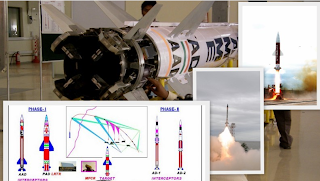India`s Ballistic Missile Defence system to be Tested

The advanced version of the indigenous Ballistic Missile Defence (BMD) system being developed by the Defence Research and Development Organisation (DRDO) will be test-fired in February and will enable the manifestation of a fully operational missile shield for vital areas and installations in the country.
The BMD system will be a two-tier system and has been upgraded for greater range. The aim of the two-tier system is to first destroy an incoming missile, at a higher altitude, in the exo-atmosphere and if that fails, the endo-atmospheric interception will take place. The Prithvi Air Defence (PAD) intercepts missiles at altitudes between 50-80 kilometres and the Advanced Air Defence (AAD) missile destroys them at heights between 15-30 kilometres.
According to DRDO, the upgraded BMD system with its missile shield will be able to intercept missiles at exo-atmospheric altitudes of 150 kilometres and endo-atmospheric height of 80 kilometres. The need to enhance the BMD system’s exo-atmospheric and endo-atmospheric altitudes was felt by the DRDO due to the modern warfare scenario where enemy missiles will need to be intercepted with more stealth and capability. The two tier-BMD system with greater altitude range will ensure that a second layer can be opted for in case of failure in the first attempt.
Last year, V.K. Saraswat, Director-General of DRDO had assured that the first phase of the indigenous Ballistic Missile Defence System to intercept and destroy incoming enemy missiles of less than 2,000-km range is expected to be deployed in two years. He added that the first phase would be made operational through the new concept of ‘capability-based deployment.’ The Air Defence Programme has been divided into two parts — depending upon the threat perception. While the first category of threats pertains to enemy missiles with less than 2,000 kilometres range, the second type belongs to those with more than 2,000 kilometres. Besides, both these phases will have two layers.
According to the DRDO, new technologies have been added and modifications have been made in the interceptor missile PAD 02 to provide higher energy, an improved guidance and control system and an integrated a Gimbaled Directional Warhead with it. The new warhead weighed only around 30 kilograms but will generate the impact of a 150 kilogram omni-directional warhead could make. The entire system is fully automated and human intervention is not needed for activation.
However, the DRDO has not been able to skirt the delays in the indigenous BMD system. Till mid 2010, it had managed to conduct only four tests of BMD system in the last four years. The first three tests in November 2006, December 2007 and March 2009 were dubbed successful, killing enemy missiles at altitudes of 48 kilometres, 15 kilometres and 80 kilometres. However, the fourth test in March 2010 was aborted midway after technical glitches. DRDO feels that if the tests in February this year are successful, the deployment of the BMD system by 2015 is a possibility. India will also fall in the elite group of four countries to have successfully developed an Anti-ballistic missile system, after United States, Russia and Israel.


0 Response to "India`s Ballistic Missile Defence system to be Tested"
Post a Comment